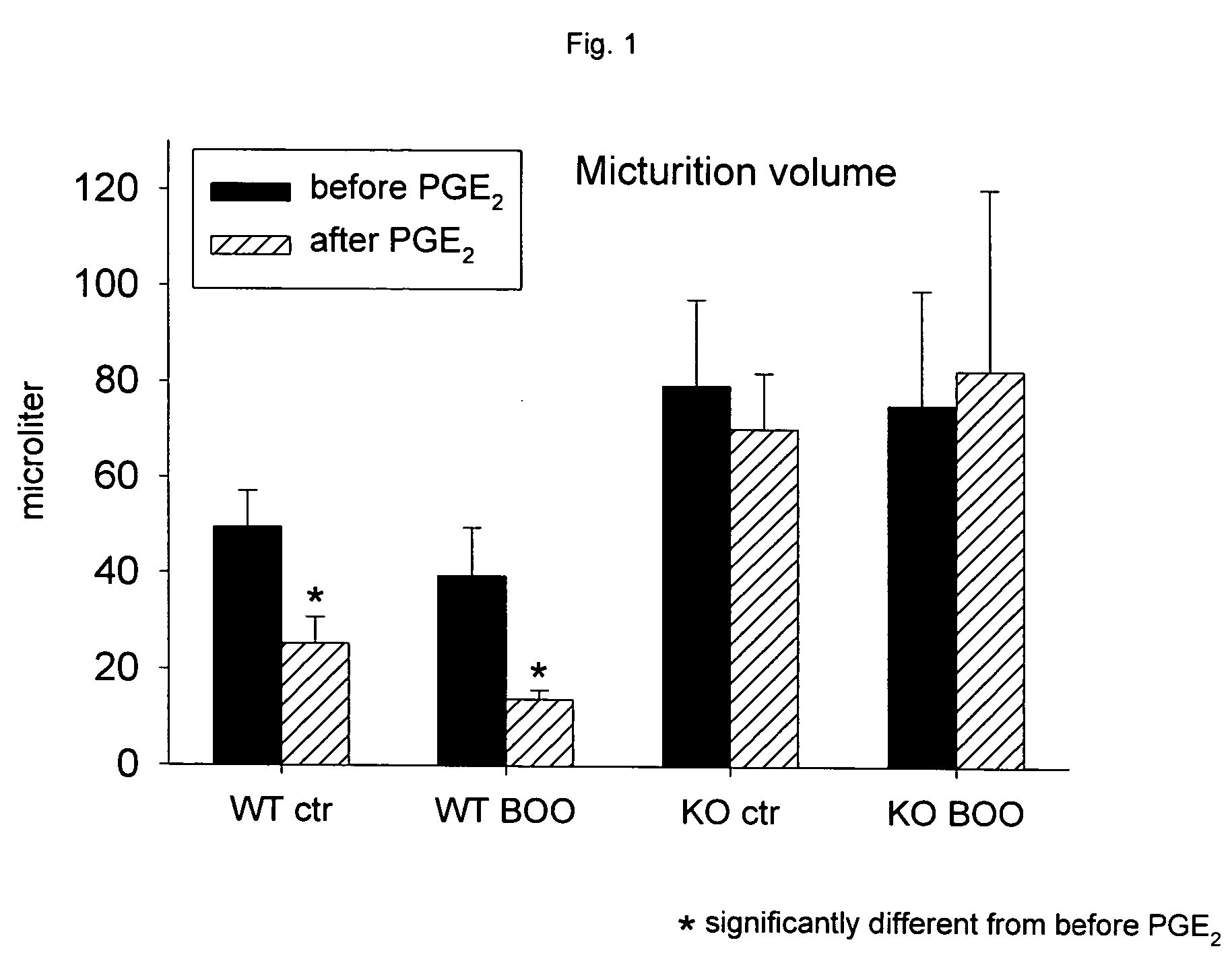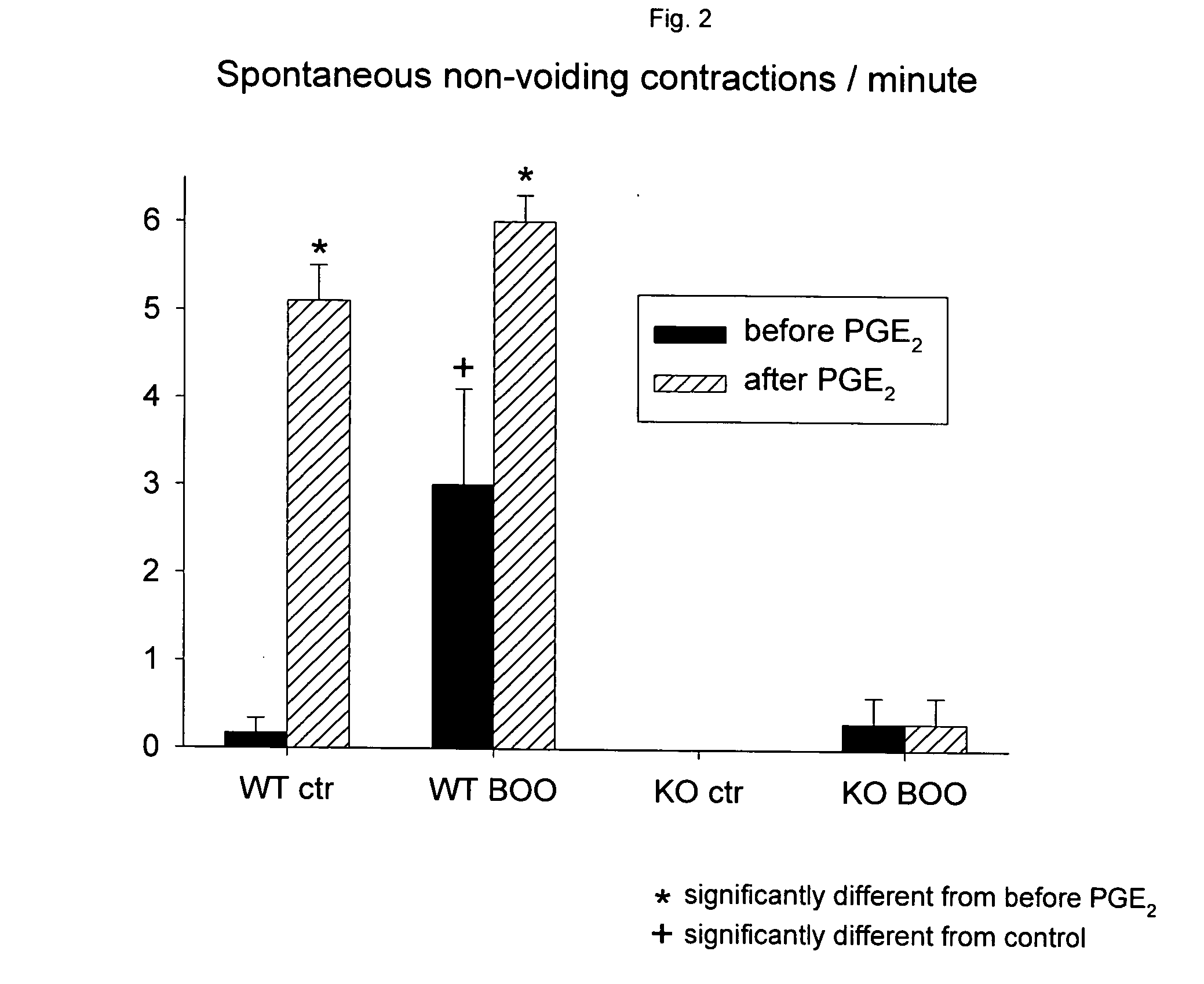Treatment of BPH
a technology of ep1 receptor and bph, which is applied in the field of bph treatment, can solve the problems of non-voiding or unstable contraction of the bladder, the contribution of prostanoids to normal physiological or indeed pathophysiological bladder function has not been well defined, and the quality of life is reduced, so as to achieve effective relief of bladder symptoms, reduce volume and bladder capacity, and alter the effect of bladder function
- Summary
- Abstract
- Description
- Claims
- Application Information
AI Technical Summary
Benefits of technology
Problems solved by technology
Method used
Image
Examples
example 1
The Beneficial Effect of an EP1 receptor Antagonist in the Treatment of LUTS Associated with BPH, Using Transgenic EP1 Knockout Mice
Materials and Methods
Animals: Age-matched female EP1 knockout (EP1KO) mice (DBA / 1LacJ background) (n=13) and DBA / 1LacJ wild type (WT) controls (n=12) were used for the studies. The knockout mice originated from Groton Laboratories, Pfizer Research and Development, the wild type from the Jackson Laboratories, USA. Both strains were delivered through Charles River Laboratories, UK. After arrival, the mice were housed for 6 weeks under identical conditions under a 12 hours light / dark photocycle, food and water were provided ad libitum. The experimental protocol was approved by the Animals Ethics Committee, Lund University.
The knockout and WT mice were randomly divided into 3 groups each. One third received bladder outlet obstruction (BOO) as described below, one third received sham surgery. The remaining mice served as unoperated controls.
Surgical ...
example 2
Ligand Binding Assay to Identify Antagonists for EP1 Receptors
Ligand binding assays can be carried out in native tissues expressing the EP1 receptor or using recombinant cell lines. The preferred method is to utilize stably expressing recombinant cell lines. EP1 binding affinity of test compounds is determined by their ability to displace [3H]-PGE2 (Dupont NEN) from from cell membranes prepared from EP1 receptor expressing cells or tissues. Specific binding is determined using standard methodologies for filtration binding assays (e.g. as described by Kiriyama et al. (1997) Br.J. Pharmacol, 1997, 122, 217-224). Affinity Ki values for test compounds are determined using IC50 values detrmined from competition binding curves and Kd values measured for the ligand.
example 3
Functional Assay (FLIPR)
Intracellular calcium release can be measured in CHO-EP1 cells using FLIPR, which allows the rapid detection of calcium following receptor activation. The CHO-EP1 cell line is maintained at 37° C. in humidified atmosphere with 5% CO2 in DMEM / Hams F12 nutrient mix supplemented with 10% fetal bovine serum, 2 mM L-glutamine, 15 mM HEPES and 400 μg / ml G418. On the afternoon before the assay cells are plated at a density of 20,000 cells per well into black sterile 96-well plates with clear bottoms to allow cell inspection and fluorescence measurements from the bottom of each well. Wash buffer containing Dulbecco's phosphate buffered saline (DPBS) and 2.5 mM probenecid and loading dye consisting of cell culture medium containing 4 μM Fluo-3-AM (dissolved in DMSO and pluronic acid, Molecular Probes) and 2.5 mM probenecid is prepared fresh on the day of assay. Compounds are solubilised in DMSO and diluted in assay buffer consisting of DPBS containing 1% DMSO, 0.1% ...
PUM
| Property | Measurement | Unit |
|---|---|---|
| Selectivity | aaaaa | aaaaa |
Abstract
Description
Claims
Application Information
 Login to View More
Login to View More - R&D
- Intellectual Property
- Life Sciences
- Materials
- Tech Scout
- Unparalleled Data Quality
- Higher Quality Content
- 60% Fewer Hallucinations
Browse by: Latest US Patents, China's latest patents, Technical Efficacy Thesaurus, Application Domain, Technology Topic, Popular Technical Reports.
© 2025 PatSnap. All rights reserved.Legal|Privacy policy|Modern Slavery Act Transparency Statement|Sitemap|About US| Contact US: help@patsnap.com



